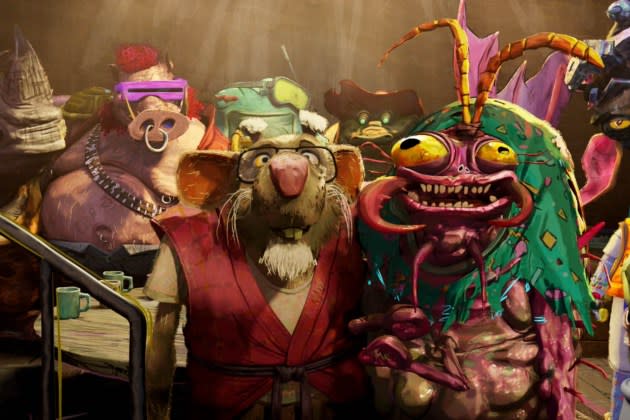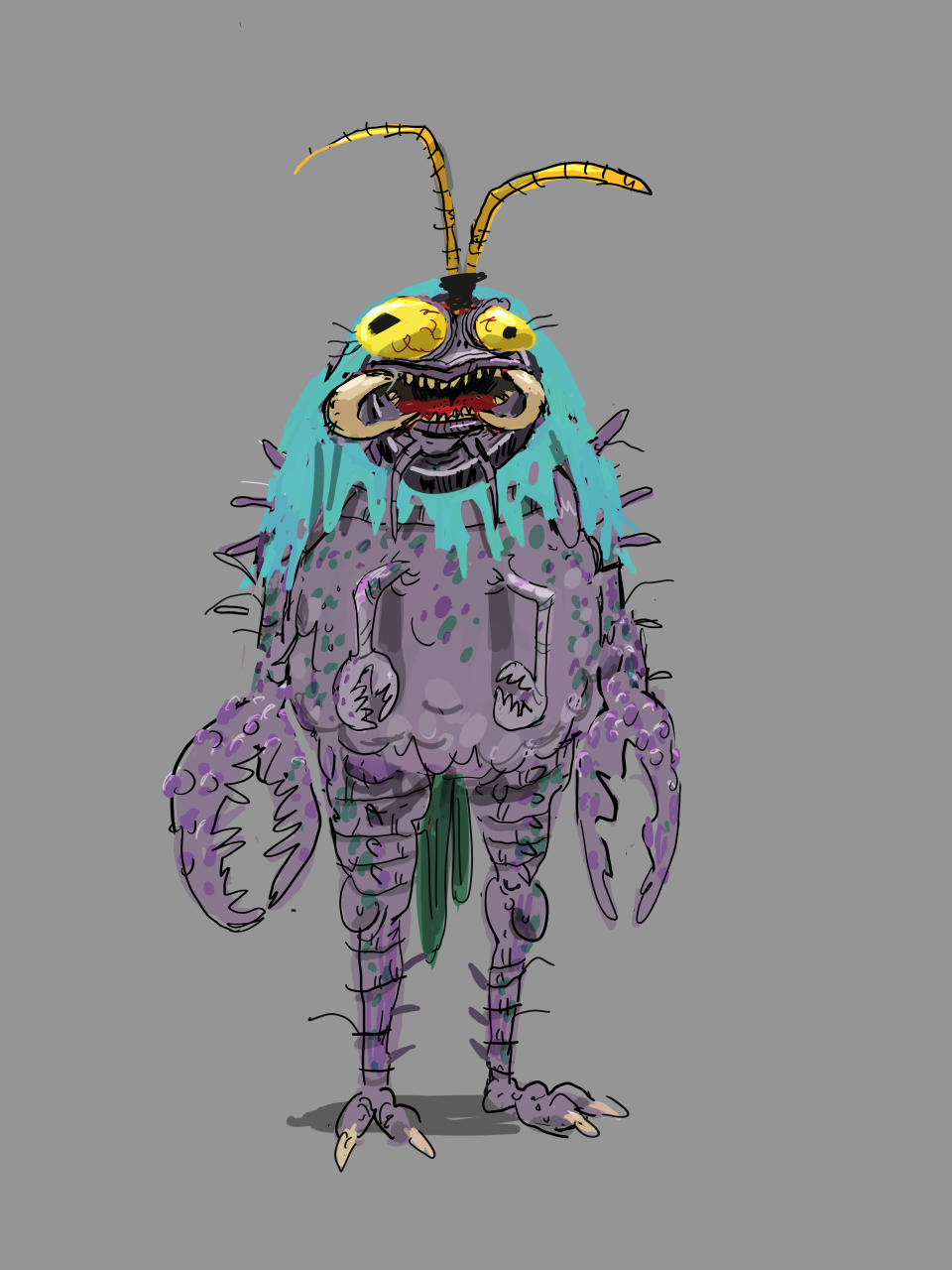Why ‘TMNT’ Animators Chose Hand-Drawn Style Over CG
- Oops!Something went wrong.Please try again later.

Reboots and remakes tread dangerous territory. Make it too much like what’s already been seen and audiences will wonder why it was made at all. Turn the wheels of something completely unexpected and you might run the whole thing off the road. If you manage to hit that sweet spot where the story and visuals bring a franchise into the now, it somehow just seems right on an organic level for fans.
When audiences watched “Teenage Mutant Ninja Turtles: Mutant Mayhem” they found themselves face to face with a Leonardo, Donatello, Michelangelo and Raphael, who had a hand-drawn feel that was distinctly different from the crisp, bright “TMNT” of the past. The story was also much less cowabunga and more teen angst.
“We were asking ourselves, what if we did something different and what if we didn’t make the faces symmetrical?” says helmer Jeff Rowe. “We pushed the proportions of the characters and we extended that to the environment, too. Me and the art team just got really excited about seeing how many traditional animation design rules we could break with the overall look of the animation but still make something that serves the story. We wanted to do something appealing, but not in the traditional way. Kids would have fun looking at this in the same way that I loved looking at ‘Rugrats.’ Those cartoons were so expressive and flawed and human and I found that relatable as a kid. I wanted to make something approachable.”
More from Variety
'Teenage Mutant Ninja Turtles: Mutant Mayhem' Hits Paramount+: Here's How To Watch The Movie Online
'Barbenheimer' Powered U.K. Box Office to $132 Million in August
That style embraced the storyteling that came from the childhood experiences of the writers. The filmmakers wanted this version of “TMNT” to contain the kind of experiences teens would find relatable and real.
“I think every teenager has some sense that they don’t feel like people are getting them and that people aren’t accepting them for who they really are, or that people aren’t liking them for who they really are,” says writer Seth Rogan. “And even if people do like them, they fear that it’s for the wrong reasons. There’s just the sense of wanting to belong and be accepted. It’s really relatable to all of us and everyone making the movie and the kids who were in the movie. It became a thing that once we started talking wabout it, it was a powerful theme that also seamlessly tied into the plot of the movie, which is that they’re mutant ninja turtles. So, it was like a lovely kind of marriage of theme and story and plot. There was this idea of them wanting to just be kind of accepted for being normal teenagers.”

Rowe found artists who came to the project with their own unique take on characters. One he found on Instagram became his lead character designer on the film. Woodrow White’s art was already pushing boundaries when the director found him. The illustrator often creates characters who are unusually shaped in unexpected color tones.
“I started doing scenes of the turtles just walking through New York that feel very loose, with the expressive quality that they wanted in our final picture,” says White. “Then, after that, we started focusing on various elements like vehicles and props and characters, but the first two characters I designed were Bebop and Rocksteady. And usually there’s like mountains of notes and like revisions but Jeff [Rowe] was special in that way. He saw what I made and thought it was perfect for the movie. I also had a lot of fun with SuperFly because he evolved from kind of a weak, sickly, pathetic character to something strong and menacing. By the time he got to be big and scary, that’s when it got fun. I really got to use my love for the Japanese monster design aesthetic in making him as gruesome and terrifying as possible. Mondo Gecko was another one that was fun because I love the early 2000s-late ’90s rave aesthetic, so I reconfigured him as skater kid.”
Rowe was set on bringing in the contributions of many different artists and art teams on the project. While external animation vendors are often given very specific directions with very little room to innovate or suggest changes, Rowe wanted Mikros Animation, their animation partner on “TMNT,” to suggest things that would serve the story and the overall hand-drawn, imperfect aesthetic of the film.
When the director invited them into the process, Matthieu Rouxel, the visual effects supervisor on TMNT and part of the team at Mikros began using techniques and tools with his team that gave Rowe the look
he wanted.
“When we started with Mikros, we wanted them to know we respected them and thought of them as filmmakers and artists who are really talented,” says Rowe. “We decided to treat this like we’re one studio and like we’re all working towards the same goal. They were invited to collaborate and invent and come up with things and stuff like a motion blur in the film, which is this really painterly kind of streaking that we didn’t ask for but one day they suggested the film should have a stylized motion blur. They showed us what they did and we said, ‘Yes, please put that put that all over the film.’ And it was just this back and forth of like us trying to improve their ideas and then them trying to improve our ideas and it was like a really collaborative, warm process.”
Rouxel understood that for the animation to serve the story — which is focused on teenaged turtles — it almost had to be done a bit haphazardly as if it was drawn in a kid’s notebook. The studio would have find a way to use its CG tools to create a 2D, tactile look.
Animators and VFX artists would have to lose that clearly drawn, hard-edged vibe in order to make it feel like they were really in the world of the story being told. In a way, it’s using the tools to do something that they were rarely used to doing since the overall CG look has been favored for so long.
“What we were trying to do is lose the detail on the characters and use shaders to get that look of something made by hand,” says Rouxel. “For us, the main challenge was to get that 2D, graphic-paper feeling like everything was made on paper by a kid drawing. So even in the backgrounds it was like you wouldn’t spend too much in detailing every break in between each of the other buildings that could be in the far, far background. So we tried to apply that same logic to all of the details. If they’re in the close background we don’t use a lot of details and then in the far, far background we don’t use it there either. Things become more like a looser shape with less details. We also developed a shader, which is the texture and reaction to light that you give to objects in a scene. This lets us effect objects in a standardized way. Everything in CG competes against this but it gives the artists a lot more room to express themselves than they usually have.”

Best of Variety
Sign up for Variety’s Newsletter. For the latest news, follow us on Facebook, Twitter, and Instagram.

